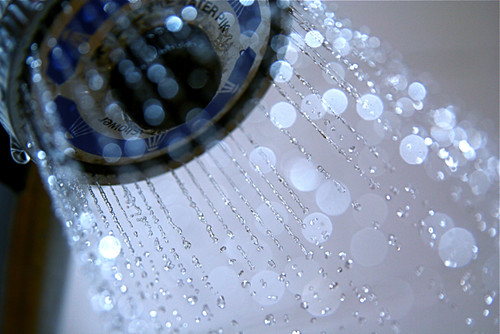 |
| Photo by stevendepolo |
Although water can seem like something we have a lot of in the Pacific Northwest, there are many good reasons to conserve it, not the least of which is the fact that hot water is the second highest energy cost for most households. This can easily add up to $200 to $500 per year for the average household! The good news is that there are many ways to use less hot water in your home without sacrificing convenience or comfort.
Install Low-Flow Fixtures
According to the EPA, showering accounts for about 17 percent of residential indoor water use in the US. The average showerhead in the US uses 2.5 gallons per minute, but by switching to a model that uses only 1.5 GPM you can save more than 2600 gallons of hot water per year. What’s more, low-flow showerheads are engineered to use less water without sacrificing performance, so you don’t have to worry about giving up good water pressure or coverage to save some money and energy.
You can also save by making sure that all of the faucets in your house have low-flow aerators installed. The aerator is the device with the screen that screws onto the faucet nozzle to control the flow of water. If you look closely, most are engraved with the flow rate of the aerator. Check all of your faucets, and if any are missing an aerator or have a flow rate above 2.0, consider installing a low flow aerator.
Turn Down Your Tank
Water heater tanks are most energy efficient at 120 degrees F, which is also the safest temperature to prevent scalding while keeping the water hot enough to fight bacterial growth in the tank. Checking your water temperature and turning your tank to 120 degrees is a great way to make sure you aren’t spending more than you need to on water heating. For every 10 degrees you lower the temperature on your water heater, you can save between 3 and 5 percent on your energy bill.
This video shows how to safely adjust your water heater temperature
Water heater tanks are most energy efficient at 120 degrees F, which is also the safest temperature to prevent scalding while keeping the water hot enough to fight bacterial growth in the tank. Checking your water temperature and turning your tank to 120 degrees is a great way to make sure you aren’t spending more than you need to on water heating. For every 10 degrees you lower the temperature on your water heater, you can save between 3 and 5 percent on your energy bill.
This video shows how to safely adjust your water heater temperature
A few safety notes:
-Turn off the power to the tank before servicing it!
-Temperatures often aren’t marked on the adjustment dial. Take the water temperature at the nearest faucet to the tank before adjusting, and then wait a day after the adjustment and take it again to make sure you reached the desired temperature.
-Turn both dials to the same temperature.
-Don’t turn your tank lower than 120 degrees, as it could allow for bacterial growth in the tank.
Stay tuned for more hot water saving tips later this week!
-Don’t turn your tank lower than 120 degrees, as it could allow for bacterial growth in the tank.
Stay tuned for more hot water saving tips later this week!
No comments:
Post a Comment